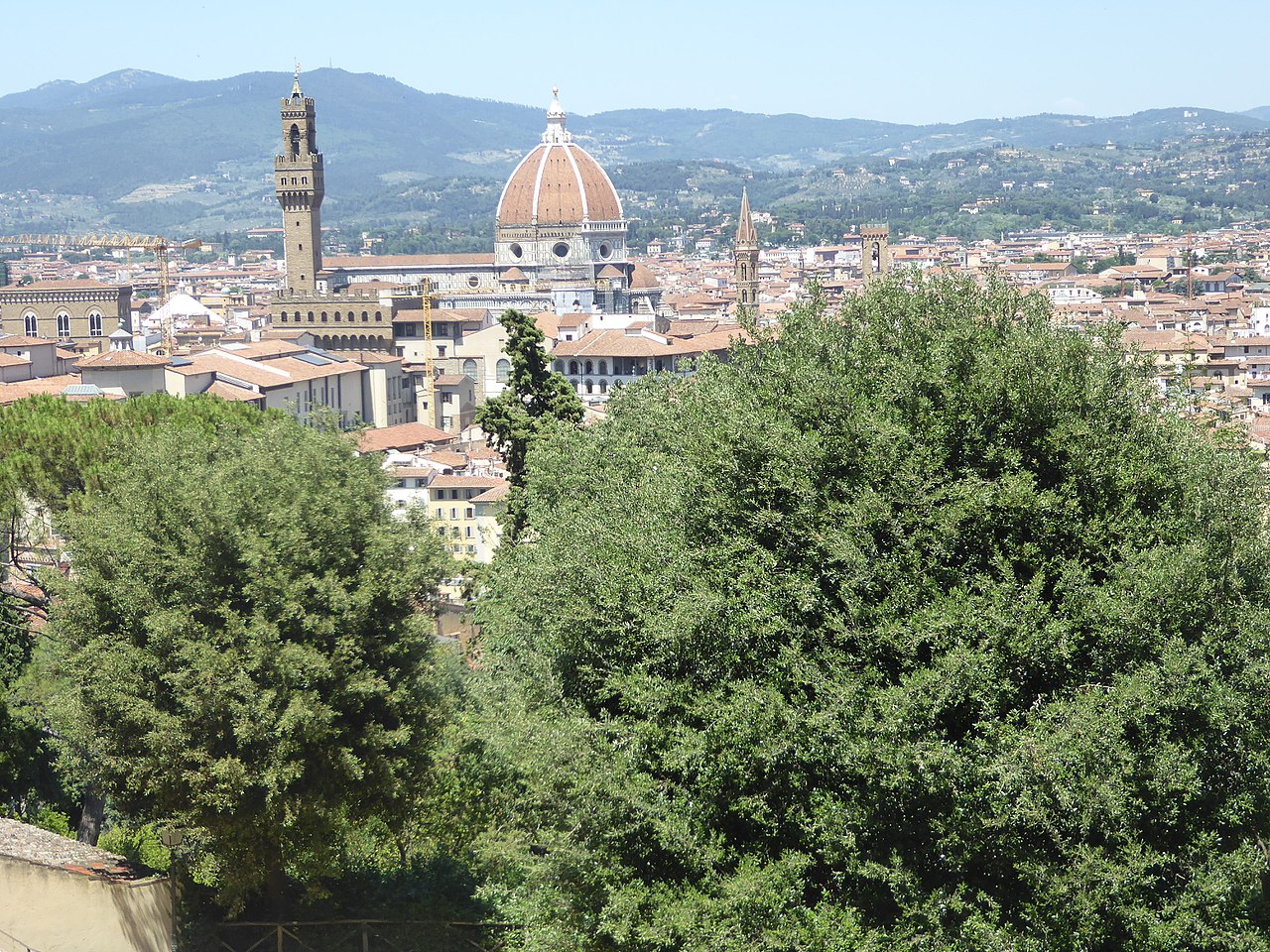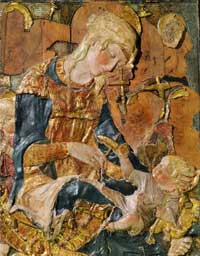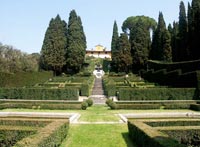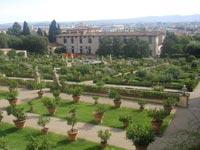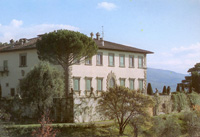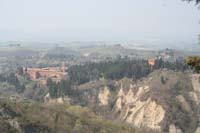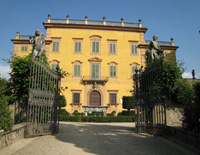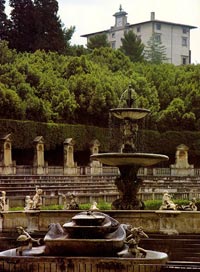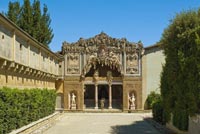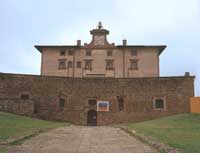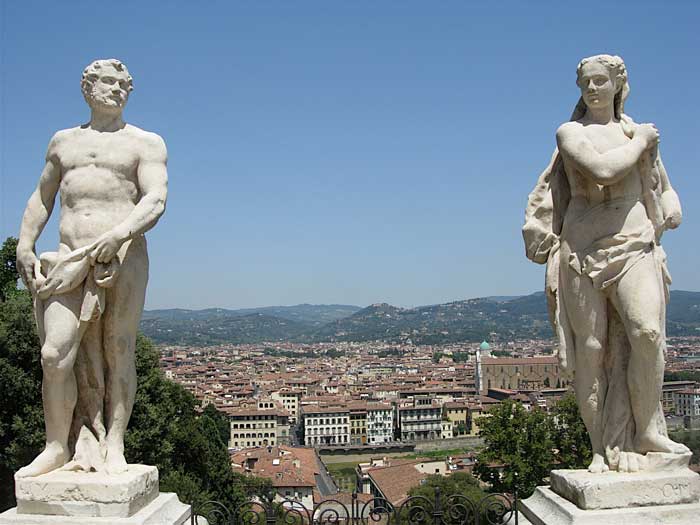 |
| Panoramic view out over Florence from the Bardini Garden, Florence. In the background Basailica Santa Croce. |
Gardens in Tuscany | The Bardini Garden in Florence |
The Bardini Garden is located on the hill right behind Palazzo Mozzi. The garden has been recently restored and reopened for visits. In 1913 Florentine antiquarian Stefano Bardini bought the whole garden and the palace: he restored and further decorated the garden, but demolished the mediaeval terraces which survived until then; he also enlarged the buildings on the side towards Costa San Giorgio. After the death of Stefano's son Ugo (1965) - and after 30 years of intricated bureaucratic disputes - the garden became property of the City of Florence.
|
Bardini Garden, images [2]
|
||||
The Baroque Stairs are the most striking decoration of the Bardini Garden; at its top is a wide terrace with a belvedere-loggia, from where we can enjoy a beautiful view on Florence. At the sides of the stairs are six fountains with mosaics and flowers.
|
||||
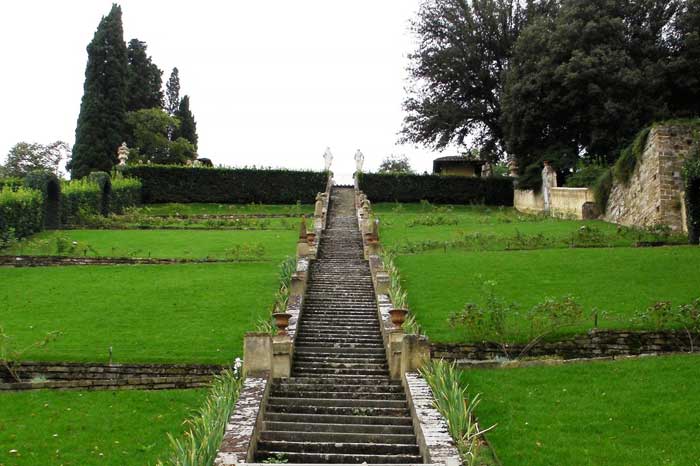 |
||||
The Baroque Stairs in the Bardini Garden, Florence
|
||||
The old gateways (porta in italian) that provided entrances through the wall are still visible throughout the city, but only the oltrarno ones on Florence's south side of the river (the youngest, built mostly in the first half of the 1300s) are still attached to their walls. Michelangelo's genius was employed (interrupting his work on the Medici chapels) to fortify the city of Florence against attack, which he did by strengthening the southern city walls around the church of San Miniato, even advising that the belltower of the church should be protected by mattresses.
|
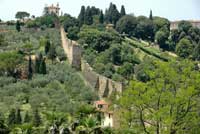 View from S. Miniato al Monte of the medieval and Renaissance fortifications that Michelangelo worked on for a year or two when the Florentine Republic was at war with the Medici supporters. Beyond, the terraces of the newly opened Bardini Gardens. |
|||
|
||||
 |
 |
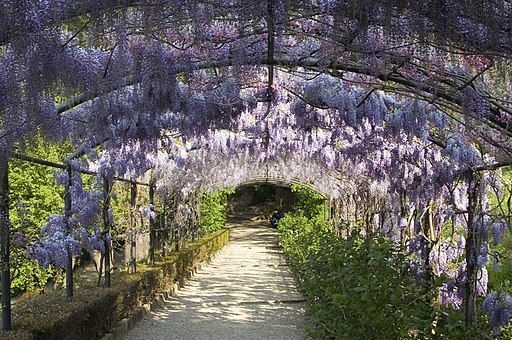 |
||
Giardino Bardini, Oltrarno, Firenze |
Giardino Bardini, la grande scalinata barocca, Oltrarno, Firenze |
Firenze, Giardino Bardini, vista sulla lussureggiante wisteria pergola |
||
The Bardini Museum |
||||
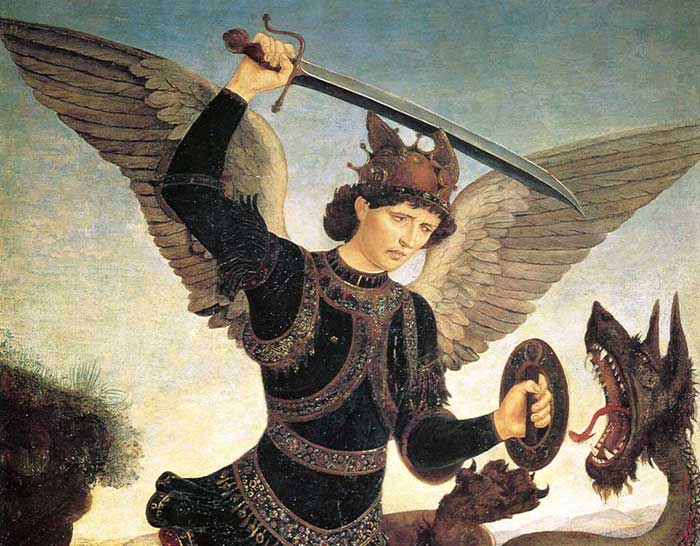 |
||||
Antonio and Piero del Pollaiuolo, St Michael and the Dragon (detail), Florence, Museo Bardini |
||||
Bardini Museum is named after its founder, the antiquarian Stefano Bardini. It contains many artworks that he collected and then donated to the City of Florence. Among the most significant works are the Madonna della Mela and the Madonna dei Cordai by Donatello, Charity by Tino da Camaino, and Antonio del Pollaiolo’s Saint Michael Archangel. |
||||
|
||||
Artist and Writer's Residency |Tuscan Holiday houses | Podere Santa Pia |
||||
Podere Santa Pia |
Podere Santa Pia, garden |
Florence, Duomo |
||
Villa I Tatti |
Parco di Villa Reale di Castello (Villa di Castello) in Florence |
Villa Gamberaia at Settignano |
||
Monte Oliveto Maggiore abbey |
Podere Santa Pia, view from the garden on the valley below |
Villa La Pietra, near Florence |
||
|
||||
The Garden of Roses is located on the Hill of San miniato. It is a lesser-known, yet wonderful Garden. Roses of many colours and species flourish here on the background of Florence. |
||||
| From Piazzale Michelangelo you can enter this unique Garden of the Iris: it is dedicated to the flower symbol of Florence. Different hybrids of this flower from many countries are in bloom here. The Garden of the Iris was created in 1954 by Mrs. Flaminia Specht and Mrs. Nita Stross Radicati, two Florentine iris cultivators, in order to provide an adequate setting for the «Premio Firenze», an international iris competition established in that year. The Councillor for Fine Arts and Gardens (Piero Bargellini, later major of Florence) recognized how important this idea was and obtained that the City Council permitted the Garden to be built on the so-called Podere dei Bastioni, an abandoned ground on the eastern side of Piazzale Michelangelo. The Garden was designed by architect G. Zetti and was inaugurated in 1957; many foreign cultivators had already donated irises and the Presby Memorial Garden di Montclair (New Jersey, USA) showed its support by donating an important collection of historical irises. In 1967 a pound surrounded by marshy ground has been added to the garden, thus providing an ideal accommodation for particular irises from Japan and Lousiana. |
||||
| The Gardens of Boboli are located right behind Pitti Palace; they are among the largest parks in Florence (45,000 square meters) and represent an excellent example of Italian gardens of 16th Century. The origin of the name Boboli is uncertain and no informations about the Gardens are available for the years between 1469 (when Pitti Palacewas built) and 1549 (when Eleanor of Toledo, wife of Cosimo I de' Medici, bought the palace and the gardens). After the Medici moved to Pitti Palace, a great transformation of the Gardens was begun, under direction of architects Ammannati, Buontalenti and then Giulio and Alfonso Parigi. The last of them completed in 1634 the great amphitheater, which was inaugurated in 1637 with a spectacle for the wedding of Ferdinando II de' Medici. In the first halfth of the 16th Century was built the imposant Vasca dell'Isolotto, with the Ocean Fountain by Giambologna. After the Dukes of Lorraine came to Florence (1739) the Gardens of Boboli were modified by the architect Jadot, who worked at the Schönbrunn palace in Vienna. From 1766 Pietro Leopoldo of Lorraine opened the Gardens to visitors: in this time Zanobi del Rosso built the Kaffeehaus pavillon and the Gardens were decorated with several ancient roman statues. In the 19th Century Boboli was in part transformed, and subsequently restored by Ferdinando III. In the years of Florence capital of Italy (1865-1871) the Gardens remained almost unmodified; in the 20th Century Boboli was frequently used as an open air theater: here were held the concert directed by Pietro Mascagni in 1906, and, since 1933, the operas of the Maggio musicale fiorentino; among them the Euridice by Jacopo Peri, under direction of Franco Zeffirelli (1960). After extensive mantainance works in 1980 the frescoes in the grotto of Buontalenti have been restored to they original beauty. In the Boboli Gardens, nature is an artwork itself. Among the various monuments built in the Gardens, we can mention the following ones: The Amphitheater, which has has been recently restored; The Grotto of Buontalenti, located near the exit to Piazza Pitti and built in 1583-88. It includes three artificial grottos with sculptures portraiting subjects of the Greek mythology and made by Baccio Bandinelli (Ceres and Apollo), Giambologna (Venus) and Vincenzo Rossi (Paris and Helena), but also copies of the Prisoners by Michelangelo. The third grotto contains Frescoes by Bernardino Poccetti; The Place of the Isolotto. From the Amphitheater starts the Viottolone («broad lane»); flanked by cypresses, it leads to the Piazzale dell'Isolotto: this place was built in 1618 from Giulio and Alfonso Parigi and takes his name from the small island («isolotto») in the pound characterizing the place. The pound itself is embellished with lemon trees and flowers, and with the statues of Perseus and Andromeda (school of Buontalenti). In the middle, a copy of the Ocean Fountain by Giambologna. Gardens in Tuscany | Boboli Gardens |
|
|||
| The old gateways (porta in italian) that provided entrances through the wall are still visible throughout the city, but only the oltrarno ones on Florence's south side of the river (the youngest, built mostly in the first half of the 1300s) are still attached to their walls. These remaining walls of the oltrarno were, in the 16th century, the only thing that stood between a bloodthirsty army and the starving Florentine population during the Siege of Florence, and witness to this terrible event, beautifully frescoed by Giorgio Vasari in the Salon of Clement VII in Palazzo Vecchio. When following a dispute between the Medici Pope Clement VII (1478-1534) and Emperor Charles V (1500-1558) the city of Rome was sacked, its citizens brutally murdered and the Pope driven out of his hiding place, Florence by 1529 was preparing for an unavoidable attack by the Emperor's Spanish armies. Michelangelo's genius was employed (interrupting his work on the Medici chapels) to fortify the city of Florence against attack, which he did by strengthening the southern city walls around the church of San Miniato, even advising that the belltower of the church should be protected by mattresses. By the early autumn of 1529 the troops, some 40,000 men strong, were spread out over the southern hills of Florence. The Florentines, protected by Michelangelo's defences, resisted until the summer of 1530, when starvation took over the population and even mice were sold for high prices in the markets. The devastated Florentines surrendered, the pope made peace and the Emperor reinstated the Medicis, placing the nineteen-year-old Alessandro de' Medici (1510-1537), illegitimate mixed race son of Pope Clement the VII, nephew of Lorenzo the Magnificent, in rule. He was to marry the fourteen-year-old daughter of the Emperor, Margaret, and several years later was murdered by his cousin, wherein Cosimo (1519-1574) was made duke of Tuscany. Forte Belvedere is a fortress built by Grand Duke Ferdinand I around 1590-1595. Designed by Bernado Buontalenti to protect the city and the Medici palace, Palazzo Pitti (it actually overlooks the Boboli Gardens, which creep up its western walls), it was additionally used to house the Medici treasury. It was accessible via the Vasari Corridor passages that run through the Pitti Palace and Boboli Gardens, connecting the fort all the way to Palazzo Vecchio. Shaped like a four-pointed star, all the walls can be seen by other walls, allowing for protection of each of the walls. However, rather than a military type of fort, the interior is actually extremely elegant, much more a sign of the prestige and luxury of the Medici family than a military fortress. Once inside the gates of the fort, a walk around the grounds will give you equally stunning views of the city of Florence and the surrounding countryside. Walking in Tuscany | Florence | San Niccolo Neighbourhood in Oltrarno Our suggested itinerary for a wonderful panoramic walk following the historic city walls continues from San Miniato church turning left onto viale Galileo. This viale winds its way along one of the most splendid panoramic views of Florence until you reach via San Leonardo, taking a right. Via San Leonardo is a walled street guarding beautiful villas and quaint little churches that once was the battleground of the Siege of Florence. At no. 64 is the villa where Russian composer Tchaikovsky lived in 1878. Rented for him by a wealthy patron who he never met but who was seemingly in love with him, Tchaikovsky was able to quietly compose his opera the Queen of Spades here. He adored Florence, calling it his “city of dreams”. No. 49 was the home of Florentine painter Ottone Rosai (1895-1957), whose minimal paintings of his street capture the characteristic light and colours of Tuscany (pictured below right). Continuing along this lovely, characteristic street you can catch glimpses of the panoramic surrounding countryside until you get to the Forte Belvedere and the 13th century Porta San Giorgio. Once arriving here, turn right onto via Belvedere, which follows the only remainders of the last of the city's walls, the ones that kept out the enemies during the Siege of Florence – watch out the occasional car on this steep downhill road. You will arrive at the bottom of the street at the Porta San Miniato, the gateway that will take you back into the town centre through the neighbourhood of via San Niccolò. An alternative route, for those who want to see a little more countryside, is to take a little street that winds behind the back of the church of San Miniato. Take the via delle Porte Sante (when you leave the church it is to your right before you go down all the steps to viale Galileo). Take a right at the intersection of via del Monte alle Croci and at your first right, turn right again onto via di Giramonte. This lovely cypress-tree lined walk will show you some beautiful countryside views. At the street Passo all'Erta, turn right and you will find yourself back on Viale Galileo. Turn left here and continue the walk as described above, to via San Leonardo. The walk from the church of San Minato to the Porta San Miniato is approximately 3km, or less than 2 miles, an hour's stroll. The entire route from the Porta San Miniato to Piazzale Michelangelo to the church of San Miniato and back through via San Leonardo is approximately 4.5km or 2.8 miles and will take around 1.5 – 2 hours as a stroll.
|
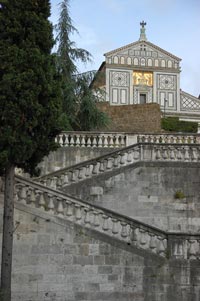 San Miniato al Monte |
|||
|
View San Niccolò in Oltrarno in a larger map |
||||
|
||||

